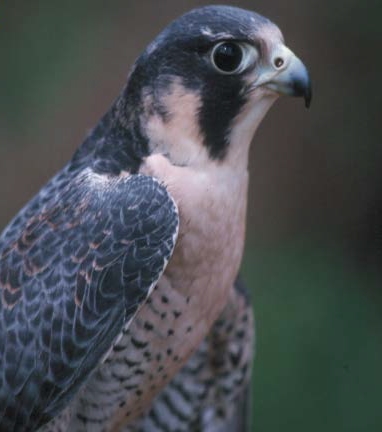Wildlife - Species

Status in SC: Endangered
Peregrine Falcon
As of 2003, the Peregrine Falcon was listed as endangered on the South Carolina Rare, Threatened and Endangered Species Inventory. In addition, the Peregrine Falcon and other birds of prey are protected by South Carolina state wildlife law section 50-11-852 which states that it is: "unlawful to molest or kill birds of prey."
Federal law protects the Peregrine Falcon under the Migratory Bird Treaty Act, while internationally, the Peregrine Falcon is protected under the Convention on International Trade in Endangered Species of Wild Fauna and Flora (CITES 1975).
Peregrine Falcon (Falco peregrinus)
Description
Adult peregrine falcons, also known as "duck hawks," are a slate-gray color on top and pale white or buff below with dark spots and bars. The adult also has a dark stripe beneath the eyes, and its size is similar to that of a crow. Young falcons are brownish-slate above with heavily streaked undersides. The beaks of peregrine falcons are equipped with a distinct notch used in severing the spinal cord of prey.
Preferred Habitat and Biology
This species of raptor has a worldwide distribution. However, it is absent from polar regions and tropical rainforests. The peregrine falcon is typically found on barrier island beaches and waterfowl impoundments in South Carolina and Georgia. They are also found in big cities where pigeons are easy and abundant prey. Peregrines do not build their own nests (called eyries); instead they use other birds' nests or crevices in trees or cliffs. Two to four creamy white eggs with reddish brown spots are laid and are incubated by both parents for about 30 days in the summer months. Young falcons are cared for by their parents and are ready to leave the nest in 35-45 days.
In South Carolina, peregrines are seen during the winter season or during their migration. There is no nesting along the coastal plains of South Carolina. A pair of falcons was observed nesting at Caesar's Head in Greenville County in 1933. Since then, no other falcons nested in the state until May of 1990. In 1990, a nesting pair was reported at Table Rock, and this area has been successfully nested ever since. Peregrine falcons feed almost exclusively on other birds, which they catch in midair. This raptor is reputedly one of the fastest animals on earth, reaching speeds of up to 200 miles per hour in a dive.
Species Significance
Populations of peregrine falcons declined precipitously in the 1950s and 1960s due primarily to pesticide use. Pesticide residues, which remain in the environment for many years, can accumulate in the tissues of small animals, such as birds and mammals, at low enough levels as not to harm the animal. However, when predators consume enough contaminated prey items, pesticides can reach harmful levels. This process is called biomagnification or bioconcentration. In the case of the peregrine falcon, DDT and related pesticides were responsible for the production of very thin eggshells that broke during incubation. The use of DDT was banned in North America, and other pesticides are closely regulated. However, countries in other areas of the world where falcons winter do not have restrictions for pesticide use.
Thanks to the implementation of captive breeding programs, populations of peregrine falcons are making a comeback. The peregrine falcon was listed as endangered under the United States Endangered Species Act of 1973. Currently it is endangered upon Similarity of Appearance because of its close resemblance to the Arctic peregrine falcon. The population is presently in good enough condition that it is being considered for de-listing as an endangered species.
References
Bull, J. L. and J. Farrand, Jr. 1995. National Audubon Society Field Guide to North American Birds. Eastern Region. The Audubon Society field guide series. Alfred A. Knopf Inc., New York, NY.
Sprunt, A., Jr. and E. B. Chamberlain. 1970. South Carolina bird life. University of South Carolina Press, Columbia, SC.
